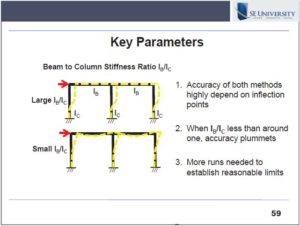Structural software has become a daily necessity for structural engineers; however, it can be to an engineer’s detriment if the fundamental concepts of structural engineering are not well understood. Having a good understanding of how structures behave can prevent devastating errors that might be overlooked in a software program. Using classical design methods, engineers can estimate the preliminary member sizes and compare the expected deflections with those of more sophisticated analysis software.
In the March 2018 session for SE University, David Odeh, SE, PE, SECB, F.SEI, F.ASCE, from Odeh Engineers, Inc., gave a presentation on Classical Design Methods. David reviewed the principles of conservation of energy and virtual work, and then outlined the portal frame method and the cantilever method as approximate ways to check more complex designs.
David emphasized the need for engineers to understand the fundamentals of mechanics and the behavior of structures, rather than rely so heavily on software to generate our designs. Thus, it is always a good idea to review concepts such as the portal frame method and cantilever method, since many engineers do not make it a habit to use these more classical design methods daily. The portal frame and cantilever methods can give an engineer a good approximation for preliminary member sizes and drift calculations, and can also serve as a check for software analysis results. Though the results may not be exact, they offer a good approximation to be sure the design is consistent with what is expected.
David referenced Structural Analysis by Hibbeler as a good source for reviewing the steps to complete the portal frame method and the cantilever method by hand or by spreadsheet. Using these methods, David explained some key parameters which help make these approximate methods more accurate. As shown in the slides below, the portal frame method is more accurate for one to two story frames, while the cantilever method is more accurate for tall, slender buildings. Also, the accuracy depends on the location of the assumed inflection points, and the beam to column stiffness ratio. Using these parameters, engineers can then double check their more complex software solutions with that of an approximate classical method to be sure their design is sound.


